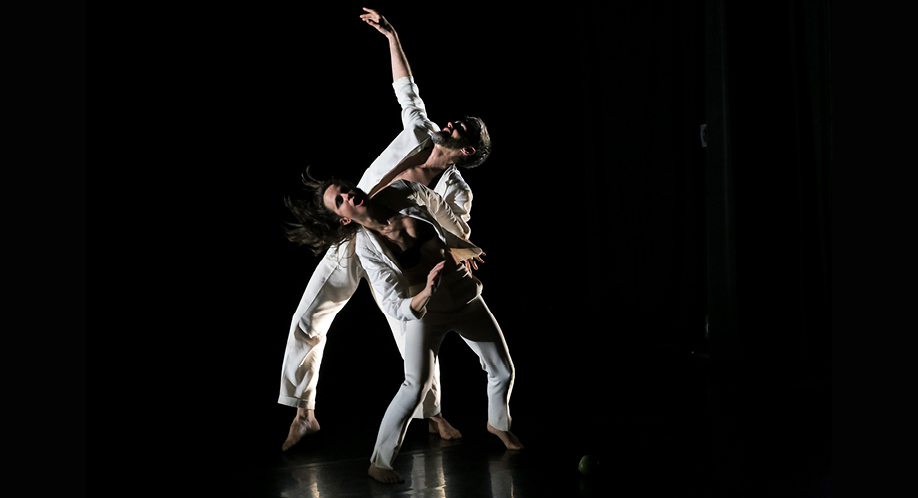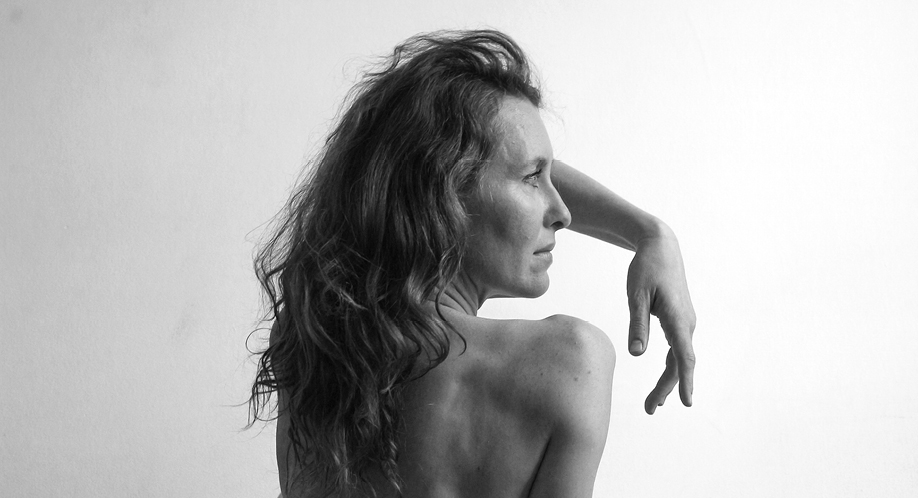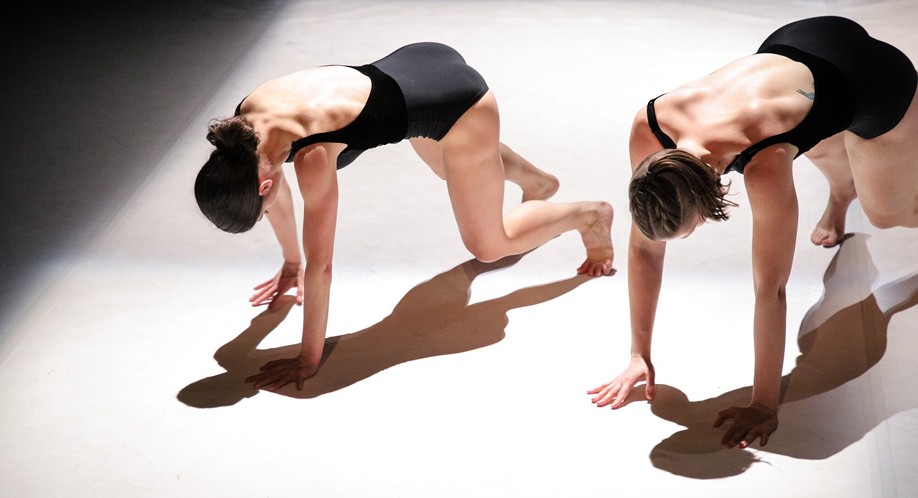Thurs Aug 15
Fri Aug 16
-
-
Sat Aug 17
-
-
Sun Aug 18
-
-
JOIN US FOR A POST SHOW CHAT:
Friday August 16, 8:00 p.m. with Alexandra Elliott, DA Hoskins and Jolene Bailie
Facilitated by Natasha Finlay*

Alexandra Elliott
Winnipeg, Manitoba
Toronto premiere
A new commission from the prolific Tedd Robinson, this ecstatically unrelenting duet is never the same twice. Spewing whispers of desire, urgency, and unattainable need, Elliott and Mozdzen transform your reality. Charles Quevillon successfully reaches into your viscera with his intoxicating sound score, injecting the performers with the physical and emotional intensity this work demands.
What keeps me going is curiosity… I still have that rock ‘n’ roll spirit. I still want to help people find what they want to do. I had those opportunities and want to encourage people to find that too. You have to take chances and trust yourself. And if you have a passion or penchant for creating something that makes you feel most open and alive, then that’s what you should be doing. That’s all.
– Tedd Robinson
Choreographer: Tedd Robinson
Dance Artists: Ian Mozdzen, Alexandra Elliott
Sound Designer: Charles Quevillon
Lighting designer: Dean Cowieson
Production Manager: jaymez
Alexandra’s Headshot by Leif Norman
After performing her own work in New York, Alexandra Elliott and Hurricane Sandy came face to face. Physically demanding and emotionally charged, her work made it back to her hometown of Winnipeg and beyond. With over ten original works under her belt, her dances have been produced in New York, Toronto, Vancouver, Edmonton, Winnipeg, and Halifax. Alex thanks Tedd Robinson for his ecstasy charged commission Logarian Rhapsody. She is the co-founder of Art Holm, a semi-annual performance series that showcases artists of different disciplines. Alex shares the role of curator and producer with fellow artist Hilary Anne Crist.
Interview with Alexandra Elliott by Grace Wells-Smith
Note: This version has been amended from the original, which stated that the title of the piece was named after Logaria, a disease state in which a person is unable to control his or her speech patterns.
Grace Wells-Smith: Your piece is called Logarian (low-garian) Rhapsody.
Alexandra Elliott: People seem to say it different ways, but we usually call it Logarian (law-garian) Rhapsody.
GWS: Where does the title come from?
AE: Tedd Robinson is the choreographer of the piece and he named it that. In reference to Logaria, the urban dictionary says “can’t control the words coming out of the mouth; one has no idea what they are saying in a sober state of reality”, which really does describe the state that Ian and I enter.
GWS: Can you tell me a bit about how the piece started?
AE: I commissioned Tedd to make this work for myself and my dance partner, Ian. This was in 2015 and at the time, Tedd was living in this big beautiful home in rural Quebec. And in his home, he had a built-in studio. So, we flew there, and we lived with him for three weeks. He would make all the meals, we would eat together, talk together, and then throughout the day he would create this twenty-minute duet that I had commissioned from him as well as his composer, Charles Quevillon. So, he came and joined for the third week … the very first thing [Tedd] had asked us to do was just to stand and look out into the distance and imagine the most beautiful thing that you can imagine so that it would bring about actual tears.
GWS: What was that like?
AE: That was a big day for me, it was like whoa! I’m surprised that I remember. I guess I’m not surprised, but I don’t often remember, necessarily, the very beginning of how a piece was made. But I definitely remember that one. And then after a few rehearsals, [Tedd] came up from the living room to the studio, and he had this beautiful, huge, green granny smith apple. So, the piece is very much about this apple. We have this apple with us the entire time, and for the whole twenty minutes we’re intensely whispering words of desire and ecstasy and warning to each other.
GWS: What’s the idea behind the apple?
AE: It’s basically the essence of temptation. We’re constantly describing how beautiful it is, how shiny, how firm, how juicy it is on the inside. I’m often telling Ian not to take it, or to give it to me, or that I will be the one to surrender. And he’s sort of saying the same thing to me. Everything we’re saying is improvised but has a very specific score or it’s always about something specific. Charles also took us to his basement sound recording studio while we were there and recorded these things that we say out loud, these whispers of desire and ecstasy. So, you also hear them in his original sound score.
GWS: What was that three-week period like?
AE: It was amazing. It was very intense just to be so focused on that. There was no running off to work, or other tasks or jobs and family and things. I really liked it. Ian and I get along really well, and I think I’m quite certain that the piece is what it is because of that intensive period. Tedd is very much a mentor. He’s an award-winning choreographer and nationally renowned, so he has a lot of experience and wisdom to share. That’s something that he does as his career as well. Artists can go and stay with him, and he acts as an artistic consultant for them and their work. I think almost every evening, Tedd and Ian would stay up late and watch old works of Tedd’s and talk about them and I’d end up having to go to bed much earlier than them. So, it was a great time.
GWS: What about these three weeks made the piece what it is today?
AE: I think just because we could focus so clearly on it. I could see that Tedd, the next day when we’d start again fresh in the morning, had already gone much deeper into the work in his mind. I find as a choreographer, my life is so busy that unless I’m in a residency away from my home, it’s really hard for me to continue to research the idea and go deeper into the idea after I’m out of the studio. So, I think that was something that we all could really do. Even outside of the studio, we could subconsciously stay immersed in the initial stages of the process.
GWS: What does it feel like to dance this work?
AE: It’s incredible. It’s like there’s always this point right near the end that I actually do feel like the stage has started to tip sideways. And whenever that happens, I know that it’s going well. It takes so much breath support to whisper for the whole twenty minutes. It takes every ounce of me physically, emotionally, and mentally. It’s so exciting because it’s never the same twice because of the words being improvised. Ian is an extremely generous performer, so he will give 110 per cent or more every single time. So, that helps me a lot because I can ride on his level. So, we have a pretty extensive warmup both physically, vocally and emotionally. It’s really exhilarating. I would say that would be the word.
GWS: What is the hardest part?
AE: For me it’s the extreme push. The extreme emotional and theatrical push. I would say for Ian, I don’t want to put words in his mouth, but when we have spoken, he comes from a theatre background, so he can go to that to that like extreme level of theatricality and emotion quite quickly. He’s very natural to go to those places. Whereas it’s less natural for me, so he helps me get to those places. Whereas for him, he came to dance much later in life. So, it’s the physicality that I find I can go to quite quickly and naturally, but for him, he tends to get me to kind of help him with that part. So, we really relied on each other that way.
GWS: What do are you hoping the audience will get from this duet?
AE: That’s a great question. I think just the same as me when I watch Tedd’s work, just sort of this electric charge. For me, when I watch a work that is so powerful and charged, it sends me back out into the world, I guess, transformed on some level. We can get really microscopic in our day to day, so it’s exciting when something can kind of blow us wide open.

DA Hoskins/The Dietrich Group
Toronto, Ontario
World Premiere
Content Warnings: loud sounds and nudity
There is an extended history between artists DA Hoskins and Danielle Baskerville – over twenty years of creative exchange. In Janus is a god we see them exploring their anthology through an embodiment of time and place indifferently gauged. Gone is the eye of a needle, the driven heightened personal and experiential pathways – what will remain is solidified matter, the mapped knowledge of a fleeting personal existence. This reflection back will act as a reflection forward – gauging and letting go of replication and emotional undercurrents – arriving in another light.
D.A. Hoskins combines intellectual rigour with emotional wallop, resulting in works that engage hearts and minds.
– Toronto Life
Choreographer/Director: DA Hoskins
Dance Artist: Danielle Baskerville
DA Hoskins’ Headshot by Nico Stagias
DA HOSKINS is a queer artist who explores dance through artistic exchange. Recipient of the Clifford E. Lee Award from the Banff Centre for the Arts, the KM Hunter Award and the Canadian Stage Award for Direction, Hoskins has created over 70 choreographic works. In 2008 he launched The Dietrich Group, a platform with which to facilitate collective explorations within his interdisciplinary dance work findings. Hoskins works for invested liberty in expression – exploring creative physical exchange through responsive and reflective immediacy. His work aims to engage the artist within a landscape of ownership and personal choice.
DANIELLE BASKERVILLE, recipient of the 2014 K.M. Hunter Award for Dance and a 2015 Dora Mavor Moore Award, works with many of Canada’s leading contemporary dance companies and creators. Recently she has performed in a site-specific opera in Burgundy, France and hosted Canada’s first-ever Trisha Brown Dance Company Intensive. Along with performing, producing and teaching dance, she is a contributor to The Dance Current and is an Executive Board Member of the Canadian Alliance of Dance Artists-Ontario.

Jolene Bailie/Gearshifting Performance Works
Winnipeg, Manitoba
Toronto Premiere
Phase Wash is motivated by how I perceive energy, memories, thoughts, hopes and sensations. I believe these elements are constantly fleeting in and out of our consciousness and that there is great power in deeply feeling something and expressing that feeling through movement. The dance expresses a connectivity, a sense of knowing, and desire. I believe the connections we have with people and locations, which at first may appear coincidental, are much more than coincidence. I believe that we can never possibly understand the depth of our surroundings and connectivity. Phase Wash gives reverence to this greater power.
Jolene Bailie
…stripped to the bone of extraneous influence while focusing on the expressive power of movement itself.
– Holly Harris, the dance current
Choreographer: Jolene Bailie
Lighting designer: Hugh Conacher
Dance Artists: Carol-Ann Bohrn, Helene Le Moullec Mancini, Aaron Paul, Sam Penner
Jolene’s Headshot by Leif Norman
Jolene Bailie is a choreographer, director, and producer of contemporary dance. Her work reflects on humanness, soul, and identity to express a deeply human experience that is honest, complex, and thorough. Jolene has presented multiple shows annually in Winnipeg since 2000, and toured her work to national and international acclaim. Past credits for d:mic/fac Mainstage, 2009 and 2013. As the Founding Artistic Director of Gearshifting Performance Works, she has created 39 original works, including ten full length works. She holds a MFA from The American Dance Festival/Hollins University and is the Artistic Director of Winnipeg’s Contemporary Dancers. Gearshifting.org.
Interview with Jolene Bailie by Grace Wells-Smith
Grace Wells-Smith: Can you tell me about your piece?
Jolene Bailie: The piece I’m presenting is an excerpt from a work called Phase Wash and we’re performing a quartet from that work. The work was premiered last year in 2018. A lot of the work that I create, [I] begin them unknowingly. I don’t say “Ok, today I’m going to start to create a new work.” I mean, you kind of know you’re going to create a new work at some point but often the process starts unintentionally. You might be in the studio doing something else and all of a sudden, the seed starts for a new piece. And this piece was motivated by many, many sorts of experiences and ideas that came together to create a piece that was an expression of my feelings that as human beings in the universe, we are connected on a much deeper level than we could possibly understand with our sort of intelligence and perception. There’s the four dancers dancing but there is a sense of giving a reverence to a greater power. That they are sort of moving within this universe. You think you might control your life but on a deeper level, maybe not.
GWS: How long is the full work?
JB: The full work is fifty-four minutes.
GWS: How did the creative process begin?
JB: It began with two dancers. The full work has eight dancers. The part we’re presenting in Toronto has four dancers. So, for the quartet that we’re presenting in Toronto, I worked just the two dancers and we worked, actually worked for about, I guess in total when you add up the days, probably two weeks on just the small, maybe six to eight-minute duet idea. Then we let that duet sit for a bit and then I brought in two more dancers to sort of build that duet into a quartet.
So, typically when I create a new work, I’ll start with one or two dancers. And as ideas become clearer, I bring more dancers into the process. That’s how I’ve worked group work since 2009 when I started hiring an ensemble of dancers. So, I work on, I guess, the essence of the idea first and see where that idea is going and then bring in additional dancers as the idea develops and is researched and reveals itself and we have a vocabulary and things like that.
GWS: Do you have anything else to say about the creative process?
JB: I have always choreographed without music, I brought music in later. I think that’s a very important part of my process. I really feel like the physicality of the choreography needs to have some sort of rhythm and musicality inherent to itself before we put music on it.
The music that we are using was recorded in a concrete cistern that was like an old water tower. The music itself reverberates in a circular pattern as opposed to how the music would reverberate in sort of a square or rectangular room. When the musicians themselves moved about in the cistern, the sound waves would change. So, the music would sound different depending on where the musicians were standing in the room.
GWS: How does the choreography develop without music?
JB: We work in silence and then sometimes I’ll play some sort of ambient soundscape music just to give some more energy in the room. And because sometimes a little bit of rhythm can help drive something once you have started. But I am fully committed to working without music until I feel like I’m going somewhere.
GWS: So, what do you think the purpose of music is with dance?
JB: I think it’s an accompaniment and a playing partner and I think we can respect it to be mobile and adaptive … For several full length works, I’ve had music created specifically for them and that’s wonderful … There is something about that willingness to just go with it and go with the flow and be in the present moment and just trust that the music is your partner and it’s going to be there for you and you’re going to be there for it. And in some ways, it almost heightens one’s responsiveness, right? Especially if you’re hearing things and you haven’t heard them for months on end. So, it’s not music that the dancers or the audience would have previous experiences with. GWS: It sounds like it could generate a really interesting response from the dancers.
JB: It does. And I think from the audience too. The audience knows so much more than we sometimes can perceive they might know. And I think they get it. Like they get that this relationship and this experience is happening right now in the present moment. And it has that real live feeling and aliveness. And even that heightened sensitivity people have on the surface of their skin or the back of their neck when they’re experiencing something that is unique, possibly new and possibly unknown. I think it’s also like wildly freeing too.
GWS: Why?
JB: Because there’s not this like a deep encoded expectation for a certain relationship to be a certain way. Like the dancers [dance] to the music in one specific way. Yes, you want to listen and be in dialogue, but I think it’s really important that there is that element of a democracy in some way.
*About the Moderator
Natasha Finlay is the choreologist and pre-show speaker for The National Ballet of Canada. Bilingual in French and English, Natasha notates works for companies including: Marie Chouinard, Peggy Baker, Paul-André Fortier, Gadfly, Little Pear Garden Collective, Kaha:wi Dance Theatre, Danny Grossman, Les Grands Ballets Canadiens and the 2019 Genée International Ballet Competition. Twice a gold medalist and ARCT recipient in Piano Performance and Piano Pedagogy with the Royal Conservatory of Music, Natasha is guest faculty at The Phil and Eli Taylor Performance Academy, training musicians to perform Baroque dances. thechoreographerstrust.wordpress.com; pianowithjennandnatasha.wordpress.com
